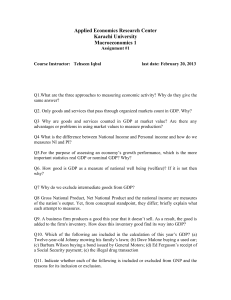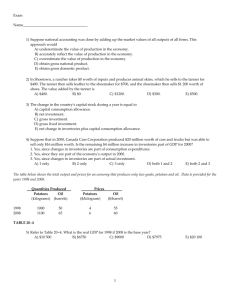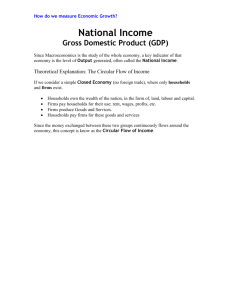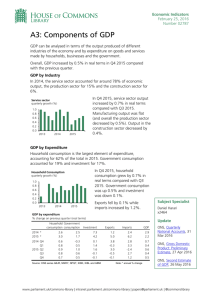Definitions - IMT-GT
advertisement
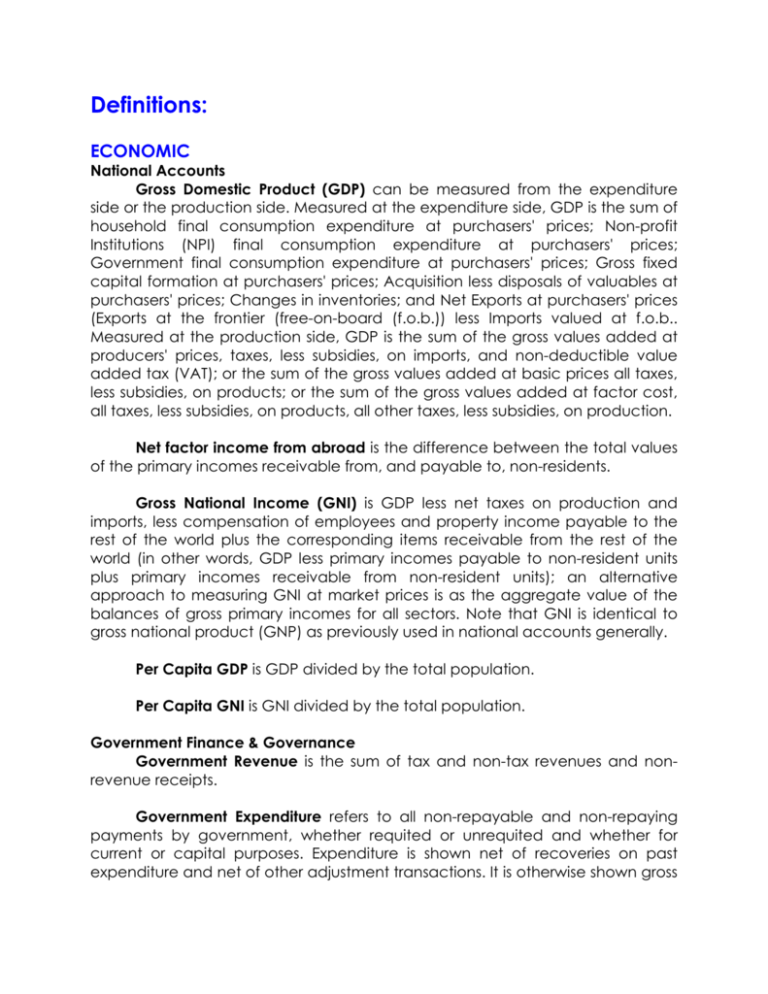
Definitions: ECONOMIC National Accounts Gross Domestic Product (GDP) can be measured from the expenditure side or the production side. Measured at the expenditure side, GDP is the sum of household final consumption expenditure at purchasers' prices; Non-profit Institutions (NPI) final consumption expenditure at purchasers' prices; Government final consumption expenditure at purchasers' prices; Gross fixed capital formation at purchasers' prices; Acquisition less disposals of valuables at purchasers' prices; Changes in inventories; and Net Exports at purchasers' prices (Exports at the frontier (free-on-board (f.o.b.)) less Imports valued at f.o.b.. Measured at the production side, GDP is the sum of the gross values added at producers' prices, taxes, less subsidies, on imports, and non-deductible value added tax (VAT); or the sum of the gross values added at basic prices all taxes, less subsidies, on products; or the sum of the gross values added at factor cost, all taxes, less subsidies, on products, all other taxes, less subsidies, on production. Net factor income from abroad is the difference between the total values of the primary incomes receivable from, and payable to, non-residents. Gross National Income (GNI) is GDP less net taxes on production and imports, less compensation of employees and property income payable to the rest of the world plus the corresponding items receivable from the rest of the world (in other words, GDP less primary incomes payable to non-resident units plus primary incomes receivable from non-resident units); an alternative approach to measuring GNI at market prices is as the aggregate value of the balances of gross primary incomes for all sectors. Note that GNI is identical to gross national product (GNP) as previously used in national accounts generally. Per Capita GDP is GDP divided by the total population. Per Capita GNI is GNI divided by the total population. Government Finance & Governance Government Revenue is the sum of tax and non-tax revenues and nonrevenue receipts. Government Expenditure refers to all non-repayable and non-repaying payments by government, whether requited or unrequited and whether for current or capital purposes. Expenditure is shown net of recoveries on past expenditure and net of other adjustment transactions. It is otherwise shown gross with the exception of departmental enterprises transactions, for which sales to the public are offset against corresponding operating expenditures. Overall budgetary surplus/deficit is revenue less operating expenditure, net of development expenditure. Cost of start-up business procedure is cost to register a business which is normalized by presenting it as a percentage of GNI per capita. Time required to start-up business is the number of calendar days needed to complete the procedures to legally operate a business. If a procedure can be expedited at additional cost, the fastest procedure, independent of cost, is chosen. Corruption perception index relates to perceptions of the degree of corruption as deemed by business people and country analysts; score ranges between 10 (highly clean) and 0 (highly corrupt). Money, Finance, & Prices M1 is the sum of currency in circulation and demand deposits. Currency in circulation refers to the notes and coins outside deposit money banks. Demand deposits comprise funds deposited at a depository institution that are payable on demand (immediately or within a very short period). The most common forms of demand deposits are checking accounts. Quasi-money is the sum of time, savings, and foreign currency deposits of resident sectors other than central government. M2 is the sum of M1 and Quasi-money. Savings deposits are interest- bearing obligations of financial institutions, other than demand deposits, that are represented by evidence of deposit, such as a passbook, and are in practice exchangeable on sight for currency, although the financial institution may have formal right to require prior notification for withdrawal. Time deposits are interest-bearing obligations of financial institutions not transferable as a means of payment, represented by evidence of deposit, and carrying a fixed maturity for withdrawal without penalty. Consumer Price Index (CPI) is an index that measures changes in the cost of a typical basket of goods and services purchased by a chosen group of consumers over time. Typically, the basket of goods and services differs among countries, and the CPI may pertain to a target group in the main city or principal cities only. The price data of the different goods and services included in the CPI are normally weighted in proportion to the relative importance of each item to total consumption expenditure. The weights are based on expenditure data collected by means of a household expenditure survey typically carried out at 5-year intervals. Most countries use a Laspeyres’ type index; some compile a retail price index which, except for its usually broader coverage of goods and services at the retail stage of distribution, is often meant to be used interchangeably with the CPI. Producer Price Index (PPI) is a measure of the change in the prices of goods and services either as they leave their place of production or as they enter the production process. A measure of the change in the prices received by domestic producers for their outputs or of the change in the prices paid by domestic producers for their intermediate inputs. GDP deflator is a measure of the annual rate of price change in the economy as a whole for the period shown obtained by dividing GDP at current prices by GDP at constant prices. Exchange rate is the value of the local currency in terms of a foreign currency (usually local currency units relative to the US dollar). It is determined by national authorities or the rate determined in the legally sanctioned exchange market. Balance of Payments Balance of Payments (BOP) is a statistical statement that systematically summarizes, for a specific time period, the economic transactions of an economy with the rest of the world. Current account covers all transactions (other than those in financial items) that involve economic values and occur between resident and nonresident entities. Also covered are offsets to current economic values provided or acquired without a quid pro quo. Specifically, the major classifications are goods and services, income, and current transfers. Goods include general merchandise which covers most movable goods that residents export to or import from non-residents, goods for processing, repairs on goods, goods procured in ports by carriers, and non-monetary gold. Services include transportation; travel; communication; construction; insurance; financial; royalties and license fees; other business; personal; cultural and recreational; government; and computer and information. Income includes compensation of employees and investment income. Current transfers are the offsets to changes which take place between residents and non-residents in ownership of real resources or financial items and whether the changes are voluntary or compulsory, do not involve a quid pro quo in economic value. Capital account includes capital transfers and acquisition/disposal of nonproduced non-financial assets. Financial account refers to financial assets and liabilities. Its components are classified according to type of investment or by functional classification. The components include direct investment, portfolio investment and other investment. Direct investment reflects the lasting interest of a resident entity in one economy (direct investor) in an entity resident in another economy (direct investment enterprise). It covers all transactions, from initial to subsequent transactions, between direct investors and direct investment enterprises and among affiliated enterprises, both incorporated and unincorporated. Portfolio investment covers transactions in equity securities and debt securities. Debt securities are sub-sectored into bonds and notes, money market instruments, and financial derivatives (such as options) when the derivatives generate financial claims and liabilities. Other investment covers short- and long-term trade credits; loans (including use of Fund credit, loans from the Fund, and loans associated with financial leases); currency and deposits (transferable and other—such as savings and term deposits, savings and loan shares, shares in credit unions, etc.); and other accounts receivable and payable. Net errors and omissions (sometimes labeled by some compilers as a balancing item or statistical discrepancy) is an item intended as an offset to the overstatement or understatement of the recorded components. Thus, if the balance of those components is a credit, the item for net errors and omissions will be shown as a debit of equal value, and vice versa. Overall BOP Balance is the sum of current, capital and financial account transactions. Special Drawing Rights (SDR) is a reserve asset whose main function is to serve as the unit of account of the IMF and some other international organizations. The SDR is neither a currency, nor a claim on the IMF, but a potential claim on the freely usable currencies of IMF members. Reserve assets cover transactions in assets that are considered by the monetary authorities of an economy to be available for use in funding payments imbalances and, in some instances, meeting other financial needs. Such availability is not closely linked in principle to formal criteria such as ownership or currency of denomination. LABOR MARKET Employed comprise all persons above a specific age who during a specified brief period, either one week or one day, were categorized as either a paid employee or self-employed. Unemployed comprise all persons above a specified age who during the reference period were "without work", i.e. were not in paid employment or selfemployment, "currently available for work" i.e. were available for paid employment or self-employment during the reference period; and "seeking work", i.e. had taken specific steps in a specified reference period to seek paid employment or self-employment. Unemployment Rate is the ratio of unemployed persons over the total labor force. Labor force is the sum of employed and unemployed. Labor force participation rate is the total number of persons in the labor force divided by the working age population, multiplied by 100. TRADE Exports represent the value of goods and related distributive services at the customs frontier of the exporting country, i.e., free-on-board (f.o.b.) value. Imports are reported in cost, insurance, and freight (c.i.f.) values. Trade balance is exports minus imports. Harmonized System Codes (HSC) is a multipurpose international product nomenclature developed by the World Customs Organization (WCO). It comprises about 5,000 commodity groups; each identified by a six digit code, arranged in a legal and logical structure and is supported by well-defined rules to achieve uniform classification. INVESTMENT Foreign Direct Investment is net inflow of investment to acquire a lasting management interest in an enterprise operating in an economy other than that of the investor. Gross Domestic Investment, with reference to Indonesia data, is the utilization of a part of the assets of the Indonesia people (including the rights and property), both owned by the state as well as national entrepreneur or foreign entrepreneurs domiciled in Indonesia, which are reserved / provided to undertake business under the stipulations of law No. 6 of 1968, either directly or indirectly. Interest rate on Savings Deposits is the rate paid by commercial and similar banks for savings deposits. Interest rate on Time deposits is the rate paid by commercial and similar banks for time deposits. Lending interest rate is the bank rate that usually caters to the short- and medium-term financing requirements of the private sector. Yield on short-term treasury bills is the rate at which short-term T-bills are issued or traded in the market. Stock Market Price Index measures the change in the prices of stocks traded in the stock exchange. Stock Market Capitalization is the price per share times the number of shares outstanding. TOURISM Visitor covers any person who travels to a country other than that in which she/he has his/her usual residence but outside his/her usual environment for a period not exceeding 12 months and whose main purpose of visit is other than the exercise of an activity remunerated from within the country visited. In this definition includes cruise passengers who arrive in a country on a cruise ship and return to the ship each night to sleep on board even though the ship remains in the port for several days. Tourist is any visitor staying for at least 24 hours but not more than one year, in the visited country with the intention of visiting for any of these purposes: pleasure; recreation sport; business; visiting friends and family; missions; attending meetings, conferences; study; and for health reasons. SOCIAL Population Population is mid-year de facto population estimates. De facto population includes all persons physically present in the country during the census day, including foreign military and diplomatic personnel and their accompanying household members, and transient foreign visitors in the country or in harbors. Crude birth rate indicates the number of live births occurring during the year (estimated at midyear), per 1,000 people. Subtracting the crude death rate from the crude birth rate provides the rate of natural increase, which is equal to the population growth. Crude death rate indicates the number of deaths occurring during the year (estimated at midyear), per 1,000 people. Fertility rate represents the number of children that would be born to a woman if she were to live to the end of her childbearing years and bear children in accordance with current age-specific fertility rates. Life expectancy at birth indicates the number of years a newborn infant would live if prevailing patterns of mortality at the time of its birth were to stay the same throughout its life. Poverty Proportion of population below $1 (PPP) a day is the percentage of the population living on less than $1.08 a day at 1993 international prices. Gini Coefficient measures the extent to which the distribution of income (or, in some cases, consumption expenditure) among individuals or households within an economy deviates from a perfectly equal distribution. Human Development Index is a summary composite index that measures a country's average achievements in three basic aspects of human development: health, knowledge, and a decent standard of living. Health is measured by life expectancy at birth; knowledge is measured by a combination of the adult literacy rate and the combined primary, secondary, and tertiary gross enrolment ratio; and standard of living by GDP per capita (PPP US$). Education Adult literacy rate is the percentage of population aged 15 years and over who can both read and write with understanding a short simple statement on his/her everyday life. Pupil-teacher ratio is the average number of pupils (students) per teacher at a specific level of education in a given school-year, based on headcounts for both pupils and teachers. This indicator is used to measure the level of human resources input in terms of number of teachers in relation to the size of the pupil population. It should normally be used to compare with established national norms on the number of pupils per teacher for each level or type of education. The ratio is calculated by dividing the total number of pupils enrolled at the specified level of education by the number of teachers at the same level. Health Births attended by skilled health personnel is the percentage of deliveries attended by personnel trained to give the necessary supervision, care, and advice to women during pregnancy, labor, and the postpartum period; to conduct deliveries on their own; and to care for newborns. Hospital beds include inpatient beds available in public, private, general, and specialized hospitals and rehabilitation centers. In most cases beds for both acute and chronic care are included. Physicians are defined as graduates of any facility or school of medicine who are working in the country in any medical field (practice, teaching, research). INFRASTRUCTURE, ENERGY & ENVIRONMENT Road Network includes motorways, highways, and main or national roads, secondary or regional roads, and all other roads in a country measured in kilometers. Paved Roads are roads surfaced with crushed stone (macadam) and hydrocarbon binder or bituminized agents, with concrete, or with cobblestones. Rail Lines refer to the length of railway route available for train service measured in kilometers, irrespective of the number of parallel tracks. Net Electricity Generation refers to the amount of gross generation less the electrical energy consumed at the generating station(s) for station service or auxiliaries. Note that electricity required for pumping at pumped-storage plants is regarded as electricity for station service and is deducted from gross generation. Telephone Line connects the subscriber’s terminal equipment to the public switched network and which has a dedicated port in the telephone exchange equipment. This term is synonymous with the term main station or direct exchange lines that are commonly used in telecommunication documents, which may not be the same as an access line or a subscriber. The number of Integrated Services Digital Network (ISDN) channels and fixed wireless subscribers should be included. If not included, it is specified in a note. Cellular Subscriber refers to a user of portable telephones subscribing to a public mobile telephone service that provides access to public switched telephone network using cellular technology. It includes postpaid and prepaid subscribers and analogue and digital cellular systems, which also include subscribers to IMT-2000 (Third Generation, 3G). Subscribers to public mobile data services or radio paging services should not be included. The name of the service and commencement year of operation is indicated in a note. Infrastructure is the second of the 12 pillars of economic competitiveness. Competitiveness is defined as the set of institutions, policies, and factors that determine the level of productivity of a country and is measured by the Global Competitiveness Index (GCI). The GCI is a weighted average of the 12 pillars of economic competitiveness. Infrastructure Quality, Overall is the average infrastructure quality score for roads, railroad infrastructure development, port infrastructure, air transport infrastructure, quality of electricity supply, available seat kilometers, and telephone line infrastructure. Infrastructure Quality, Railroad Infrastructure Development refers to effective railroads infrastructure for transport of goods, people, and services that enable entrepreneurs to get their goods to market in a secure and timely manner, and facilitate the movement of workers to the most suitable jobs. Infrastructure Quality, Port Infrastructure refers to effective port infrastructure for transport of goods, people, and services that enable entrepreneurs to get their goods to market in a secure and timely manner, and facilitate the movement of workers to the most suitable jobs. Infrastructure Quality, Air Transport Infrastructure refers to effective air transport infrastructure for movement of goods, people, and services that enable entrepreneurs to get their goods to market in a secure and timely manner, and facilitate the movement of workers to the most suitable jobs. Infrastructure Quality, Electricity Supply refers to electricity supplies that are free of interruptions and shortages so that businesses and factories can work without impediment. Infrastructure Quality, New Telephone/Fax Infrastructure refers to a solid and extensive telecommunications network that allows for a rapid and free flow of information, which increases overall economic efficiency by helping to ensure that decisions made by economic actors take into account all available relevant information. Private Sector Investment in Infrastructure refers to total project investments in infrastructure made by the private sector. With few exceptions, the investment amounts represent the total investment commitments entered into by the project entity at the beginning of the project (at contract signature or financial closure), not the planned or executed annual investments. Private Sector Investment in Infrastructure as a proportion of GDP (%) is the percentage share of private sector investment in infrastructure to total GDP. Crude petroleum or crude oil is a mineral oil consisting of a mixture of hydrocarbons of natural origin, yellow to black in color, of variable density and viscosity. Data in this category also includes lease or field condensate (separator liquids) which is recovered from gaseous hydrocarbons in lease separation facilities, as well as synthetic crude oil, mineral oils extracted from bituminous minerals such as shales and bituminous sand, and oils from coal liquefaction. Data on production refer to the first stage of production i.e. at oil wells. Exports refer to all energy commodities leaving the national boundary of a country. Imports refer to all energy commodities entering the national boundary of a country. Data on consumption refer to "apparent consumption" and are derived from the formula "production + imports - exports - bunkers +/- stock changes." Coal consists of proven reserves of anthracite, bituminous and brown coal deposits. Anthracite which is also known as steam coal is coal used for steam raising and space heating purposes. Bituminous coal is an organic sedimentary rock formed by diagenetic and submetamorphic compression of peat bog material. Brown coal is coal with a low degree of coalification which retained the anatomical structure of the vegetable matter from which it was formed. Natural gas refers to gases consisting mainly of methane occurring naturally in underground deposits. It includes both non-associated gas (originating from fields producing only hydrocarbons in gaseous form) and associated gas (originating from fields producing both liquid and gaseous hydrocarbons), as well as methane recovered from coal mines and sewage gas. Natural gas liquids (NGL) are Liquid or liquefied hydrocarbons produced in the manufacture, purification and stabilization of natural gas. NGL’s include, but are not limited to, ethane, propane, butane, pentane, natural gasoline, and plant condensate. NGL’s are either distilled with crude oil in refineries, blended with refined petroleum products, or used directly depending on their characteristics. Electricity production refers to gross production, which includes the consumption by station auxiliaries and any losses in the transformers that are considered integral parts of the station. Also Included is total electric energy produced by pumping installations without deduction of electric energy absorbed by pumping. Data on consumption refer to "apparent consumption" and are derived from the formula "production + imports - exports - bunkers +/stock changes." Gasoline is Light hydrocarbon oil for use in internal combustion engines such as motor vehicles, excluding aircraft. Premium gasoline has an antiknock index, i.e., octane rating, greater than 90. Note: Octane requirements may vary by altitudes or fluids at various depths beneath the surface of the earth. The energy is extracted by drilling and/or pumping. Diesel or gas-diesel oil refers to heavy oils distilling between 200oC and 380°C, but distilling less than 65% in volume at 250°C, including losses, and 85% or more at 350°C. Its flash point is always above 50°C and its specific gravity is higher than 0.82. Gas-diesel oils are used as a fuel for internal combustion in diesel engines, as a burner fuel in heating installations, such as furnaces, and for enriching water gas to increase its luminosity. GDP per unit of energy use is the PPP GDP per kilogram of oil equivalent of energy use. PPP GDP is gross domestic product converted to 2005 constant international dollars using purchasing power parity (PPP) rates. An international dollar has the same purchasing power over GDP as a U.S. dollar has in the United States. Proportion of Land Area covered by Forest refers to the area of forest as a share of total land area, where land area is the total country area excluding the area of inland water bodies (major rivers, lakes and water reservoirs). Forest is land spanning more than 0.5 hectares with trees higher than 5 meters and a canopy cover of more than 10%; or trees able to reach these thresholds in situ and does not include land that is predominantly under agricultural or urban land use. Carbon Dioxide Emissions are anthropogenic emissions, less removal by sinks, of carbon dioxide (CO2). Emissions from all national activities are considered. Typical sectors for which CO2 emissions/removals are estimated are energy, industrial processes, agriculture; waste, and the sector of land use, landuse change, and forestry. CO2 emissions per capita are total CO2 emissions divided by the population. Proportion of Population with Access to Improved Water Source is the percentage of the population using improved drinking water sources (including household water connection, public standpipe, borehole, protected dug well, protected spring, rainwater collection, and bottled). Proportion of Population with Access to Improved Sanitation is the percentage of population using an improved sanitation facility (including flush/pour flush toilet or latrine to: piped sewerage, septic tank or pit, a ventilated improved pit latrine, a pit latrine with slab or a composting toilet/latrine). Sources: BPS Statistics Indonesia website (http://www.bps.go.id) Energy Information Administration (EIA) website (http://www.eia.doe.gov). Glossary. International Labor Organization (ILO), LABORSTA Internet (http://laborsta.ilo.org). International Monetary Fund (IMF) website (http://www.imf.org/external/index.htm). Balance of Payments Manual. International Monetary Fund (IMF) website (http://www.imf.org/external/index.htm). Government Finance Statistics Manual 1986 and 2001. Investment and Promotion Board of North Sumatra website (http://www.bkpmdsumut.go.id/capital.php) The World Bank Group. Private Participation in Infrastructure Database (http://ppi.worldbank.org/index.aspx). Data Methodology. Transparency International website (http://www.transparency.org). United Nations Statistics Division (UNSD). Millenium Development Goals (MDG) Indicators Online (http://mdgs.un.org/unsd/mdg). Organization for Economic Co-operation and Development (OECD) website (http://www.oecd.org). Glossary of Statistical Terms UNESCO. Institute of Statistics (UIS) website (http://www.uis.unesco.org/ev.php?ID=2867_201&ID2=DO_TOPIC). Glossary. United Nations. 2004 Energy Statistics Yearbook. New York: United Nations Reproduction Section. United Nations Statistics Division (UNSD) website (http://unstats.un.org/unsd/default.htm). System of National Accounts 1993. United Nations Statistics Division (UNSD), UNData Online (http://data.un.org). Glossary. World Customs Organization (WCO) website (http://www.wcoomd.org) World Economic Forum. 2008. The Global Competitiveness Report 2008-2009. Switzerland: SRO-Kundig. World Bank. World Development Indicators (WDI) Online (http://ddpext.worldbank.org/ext/DDPQQ/member.do?method=getMembers&userid=1&q ueryId=135). Notes.



